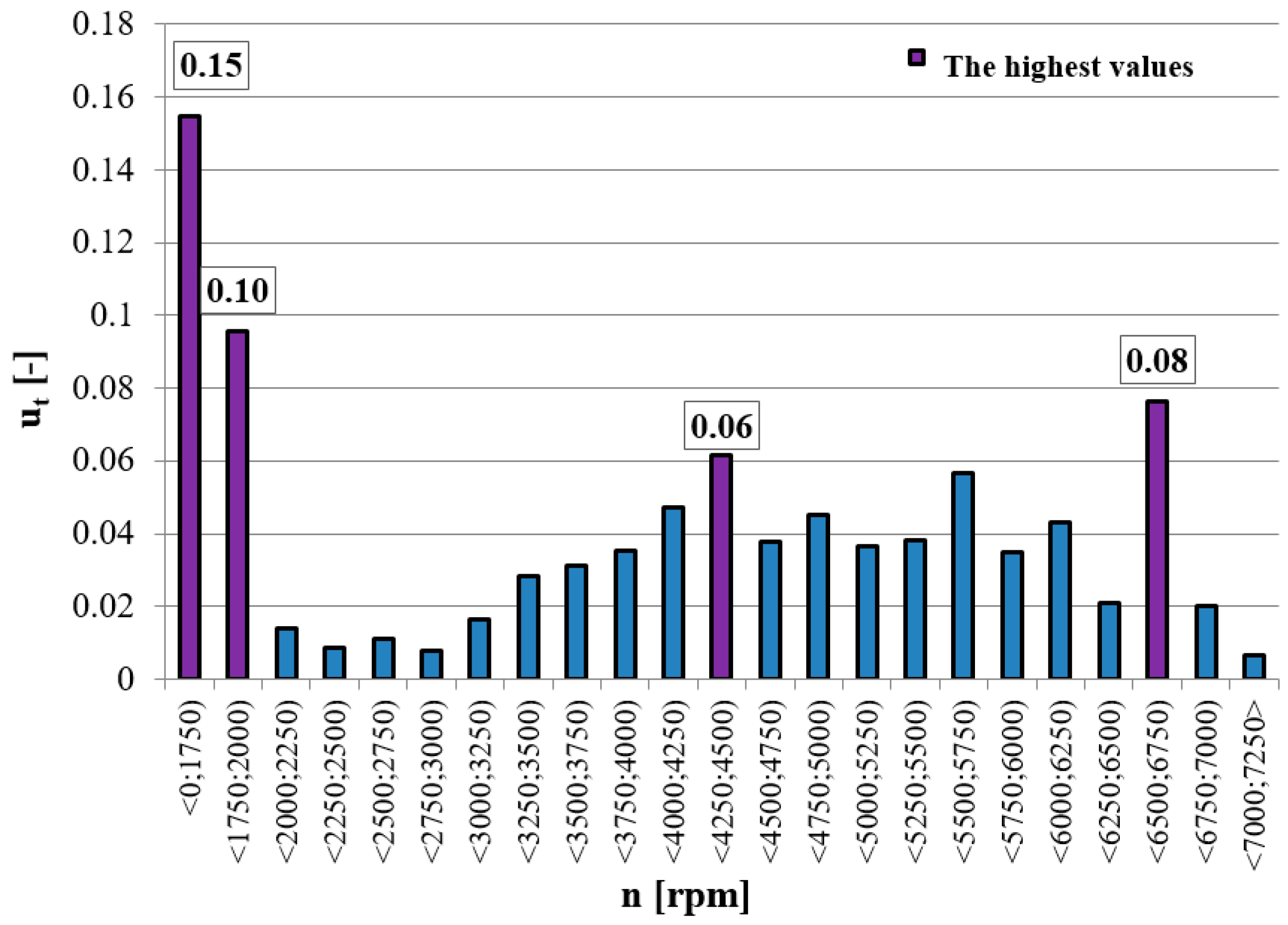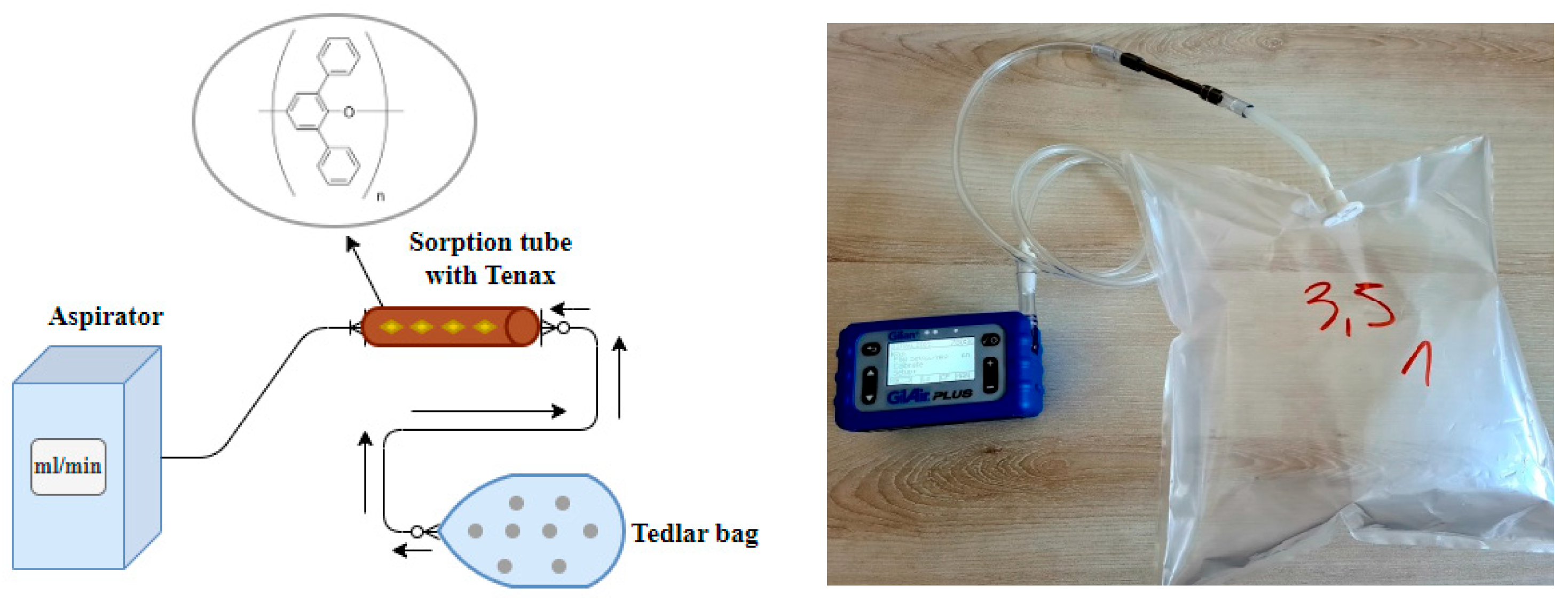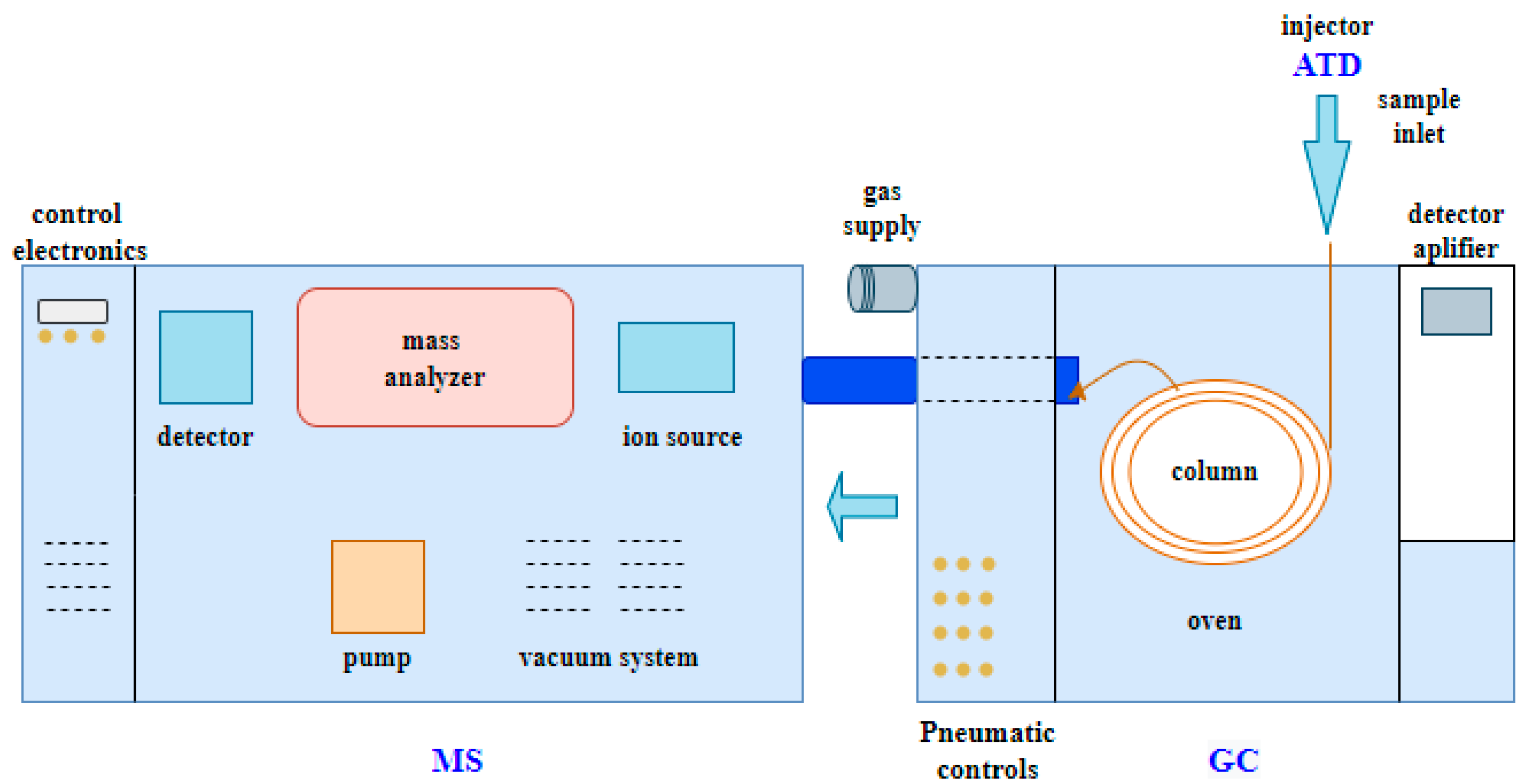Chromatographic Analysis of the Chemical Composition of Exhaust Gas Samples from Urban Two-Wheeled Vehicles
Abstract
:1. Introduction
2. Materials and Methods
2.1. Collection and Preparation of Measurement Samples
2.2. Measuring Equipment
2.3. Conditions of Chromatographic Analysis
- initial temperature: 50 °C, maintained for 2 min;
- temperature level 1: 7 °C/min to reach a temperature of 160 °C;
- temperature level 2: 10 °C/min to reach a temperature of 280 °C, maintained for 4.29 min (Figure 6).
3. Chromatographic Analysis of the Chemical Composition of Exhaust Gas Samples
4. Conclusions
- The results of the qualitative analysis of chemical components indicate the presence of alkenes, alkanes, aliphatic aldehydes, aromatic and cyclic hydrocarbons (cycloalkanes) in the tested samples. Most of them have a negative impact on the environment as well as on human health. However, it is not known whether the samples contained significant or trace amounts. Therefore, further research is necessary, i.e., quantitative analysis of exhaust gases from the discussed group of vehicles, taking into account the specificity of the operation of urban two-wheeled vehicles. The literature review showed a lack of this type of research for vehicles in this category.
- The qualitative assessment of exhaust gas samples showed that the two-wheeled vehicle had a greater qualitative diversity depending on the engine operating point (crankshaft rotation speed) in the case of derivatives of aromatic hydrocarbons from the BTX group, which are particularly important in terms of toxicology.
- The presented research and the obtained results showed that there is a need to extend the approval tests of two-wheeled vehicles to include chromatographic analysis. The authors suggest collecting exhaust gas samples while the engine is idling in cold and hot thermal states for further chromatographic analysis.
- The need to perform chromatographic analyzes in this type of approval process would force manufacturers of two-wheeled vehicles to use design solutions aimed at meeting specific permissible values of chemical compounds. As a consequence, the air quality in many crowded urban centers would improve.
Author Contributions
Funding
Data Availability Statement
Conflicts of Interest
References
- European Union. Directive 2004/42/CE of the European Parliament and of the Council of 21 April 2004 on the Limitation of Emissions of Volatile Organic Compounds Due to the Use of Organic Solvents in Certain Paints and Varnishes and Vehicle Refinishing Products and Amending Directive 1999/13/EC 2004; European Union: Brussels, Belgium, 2004. [Google Scholar]
- Bebkiewicz, K.; Boryń, E.; Chłopek, Z.; Chojnacka, K.; Doberska, A.; Kanafa, M.; Kargulewicz, I.; Olecka, A.; Rutkowski, J.; Skośkiewicz, J.; et al. Krajowy Bilans Emisji SO2, NOx, CO, NH3, NMLZO, Pyłów, Metali Ciężkich i TZO Za Lata 1990–2020. 2022. Available online: https://www.kobize.pl/uploads/materialy/materialy_do_pobrania/krajowa_inwentaryzacja_emisji/Bilans_emisji_za_2020.pdf (accessed on 30 November 2023).
- Materiał Dotyczący Regulacji Oraz Wymagań w Zakresie Bilansowania Emisji Niemetanowych Lotnych Związków Organicznych (NMLZO) 2015. Available online: https://krajowabaza.kobize.pl/docs/bilansowanie_LZO_aktualizacja-final-15-12-2015.pdf (accessed on 4 December 2023).
- Manahan, S.; Środowiska, T. Aspekty Chemiczne i Biochemiczne; Wydawnictwo Naukowe PWN: Warszawa, Poland, 2006. [Google Scholar]
- Kęska, A. Metoda Oceny Toksyczności Spalin Silnikowych w Aspekcie Analizy Rozwoju Standardów Emisyjnych. Rap. Wydziału Mech. Politech. Wrocławskiej 2020, 26, 155. [Google Scholar]
- Di Francesco, F.; Loccioni, C.; Fioravanti, M.; Russo, A.; Pioggia, G.; Ferro, M.; Roehrer, I.; Tabucchi, S.; Onor, M. Implementation of Fowler’s Method for End-Tidal Air Sampling. J. Breath Res. 2008, 2, 037009. [Google Scholar] [CrossRef]
- Ge, J.C.; Kim, H.Y.; Yoon, S.K.; Choi, N.J. Reducing Volatile Organic Compound Emissions from Diesel Engines Using Canola Oil Biodiesel Fuel and Blends. Fuel 2018, 218, 266–274. [Google Scholar] [CrossRef]
- Hu, N.; Tan, J.; Wang, X.; Zhang, X.; Yu, P. Volatile Organic Compound Emissions from an Engine Fueled with an Ethanol-Biodiesel-Diesel Blend. J. Energy Inst. 2017, 90, 101–109. [Google Scholar] [CrossRef]
- Jin, D.; Choi, K.; Myung, C.-L.; Lim, Y.; Lee, J.; Park, S. The Impact of Various Ethanol-Gasoline Blends on Particulates and Unregulated Gaseous Emissions Characteristics from a Spark Ignition Direct Injection (SIDI) Passenger Vehicle. Fuel 2017, 209, 702–712. [Google Scholar] [CrossRef]
- Salvo, P.; Ferrari, C.; Persia, R.; Ghimenti, S.; Lomonaco, T.; Bellagambi, F.; Di Francesco, F. A Dual Mode Breath Sampler for the Collection of the End-Tidal and Dead Space Fractions. Med. Eng. Phys. 2015, 37, 539–544. [Google Scholar] [CrossRef] [PubMed]
- Volckens, J.; Olson, D.A.; Hays, M.D. Carbonaceous Species Emitted from Handheld Two-Stroke Engines. Atmos. Environ. 2008, 42, 1239–1248. [Google Scholar] [CrossRef]
- Wang, X.; Ge, Y.; Zhang, C.; Tan, J.; Hao, L.; Liu, J.; Gong, H. Effects of Engine Misfire on Regulated, Unregulated Emissions from a Methanol-Fueled Vehicle and Its Ozone Forming Potential. Appl. Energy 2016, 177, 187–195. [Google Scholar] [CrossRef]
- Xiao, Q.; Li, M.; Liu, H.; Fu, M.; Deng, F.; Lv, Z.; Man, H.; Jin, X.; Liu, S.; He, K. Characteristics of Marine Shipping Emissions at Berth: Profiles for Particulate Matter and Volatile Organic Compounds. Atmos. Chem. Phys. 2018, 18, 9527–9545. [Google Scholar] [CrossRef]
- Zhao, H.; Ge, Y.; Zhang, T.; Zhang, J.; Tan, J.; Zhang, H. Unregulated Emissions from Diesel Engine with Particulate Filter Using Fe-Based Fuel Borne Catalyst. J. Environ. Sci. 2014, 26, 2027–2033. [Google Scholar] [CrossRef] [PubMed]
- Hata, H.; Okada, M.; Funakubo, C.; Hoshi, J. Tailpipe VOC Emissions from Late Model Gasoline Passenger Vehicles in the Japanese Market. Atmosphere 2019, 10, 621. [Google Scholar] [CrossRef]
- Chin, J.-Y.; Batterman, S.A.; Northrop, W.F.; Bohac, S.V.; Assanis, D.N. Gaseous and Particulate Emissions from Diesel Engines at Idle and under Load: Comparison of Biodiesel Blend and Ultralow Sulfur Diesel Fuels. Energy Fuels 2012, 26, 6737–6748. [Google Scholar] [CrossRef] [PubMed]
- Alves, C.A.; Lopes, D.J.; Calvo, A.I.; Evtyugina, M.; Rocha, S.; Nunes, T. Emissions from Light-Duty Diesel and Gasoline in-Use Vehicles Measured on Chassis Dynamometer Test Cycles. Aerosol Air Qual. Res. 2015, 15, 99–116. [Google Scholar] [CrossRef]
- Gawron, B.; Górniak, A.; Białecki, T.; Janicka, A.; Włostowski, R.; Włóka, A.; Molska, J.; Zawiślak, M. Impact of a Synthetic Component on the Emission of Volatile Organic Compounds during the Combustion Process in a Miniature Turbine Engine. Energies 2021, 14, 8462. [Google Scholar] [CrossRef]
- Janicka, A.B.; Zawiślak, M.; Gawron, B.; Górniak, A.; Białecki, T. Emission of Volatile Organic Compounds during Combustion Process in a Miniature Turbojet Engine. Environ. Prot. Eng. 2018, 44, 57–67. [Google Scholar] [CrossRef]
- Kim, H.Y.; Choi, N.J. Study on Volatile Organic Compounds from Diesel Engine Fueled with Palm Oil Biodiesel Blends at Low Idle Speed. Appl. Sci. 2020, 10, 4969. [Google Scholar] [CrossRef]
- Nakashima, Y.; Kamei, N.; Kobayashi, S.; Kajii, Y. Total OH Reactivity and VOC Analyses for Gasoline Vehicular Exhaust with a Chassis Dynamometer. Atmos. Environ. 2010, 44, 468–475. [Google Scholar] [CrossRef]
- Tsai, J.-H.; Huang, P.-H.; Chiang, H.-L. Characteristics of Volatile Organic Compounds from Motorcycle Exhaust Emission during Real-World Driving. Atmos. Environ. 2014, 99, 215–226. [Google Scholar] [CrossRef]
- Tsai, J.-H.; Yao, Y.-C.; Huang, P.-H.; Chiang, H.-L. Criteria Pollutants and Volatile Organic Compounds Emitted from Motorcycle Exhaust under Various Regulation Phases. Aerosol Air Qual. Res. 2017, 17, 1214–1223. [Google Scholar] [CrossRef]
- Grote, C.; Pawliszyn, J. Solid-Phase Microextraction for the Analysis of Human Breath. Anal. Chem. 1997, 69, 587–596. [Google Scholar] [CrossRef]
- Costagliola, M.; De Simio, L.; Iannaccone, S.; Prati, M. Combustion Efficiency and Engine out Emissions of a SI Engine Fueled with Alcohol/Gasoline Blends. Appl. Energy 2013, 111, 1162–1171. [Google Scholar] [CrossRef]
- Costagliola, M.A.; Murena, F.; Prati, M.V. Exhaust Emissions of Volatile Organic Compounds of Powered Two-Wheelers: Effect of Cold Start and Vehicle Speed. Contribution to Greenhouse Effect and Tropospheric Ozone Formation. Sci. Total Environ. 2014, 468, 1043–1049. [Google Scholar]
- Mattrel, P.; Vasic, A.-M.; Gujer, E.; Haag, R.; Weilenmann, M. VOC Composition and Ozone-Forming Potential of the Exhaust Gas of in-Use Motorcycles. Int. J. Environ. Pollut. 2004, 22, 301–311. [Google Scholar] [CrossRef]
- Merkisz, J.; Lijewski, P.; Fuc, P.; Siedlecki, M.; Ziolkowski, A. Development of the Methodology of Exhaust Emissions Measurement under RDE (Real Driving Emissions) Conditions for Non-Road Mobile Machinery (NRMM) Vehicles; IOP Publishing: Bristol, UK, 2016; Volume 148, p. 012077. [Google Scholar]
- Bielaczyc, P.; Merkisz, J.; Pielecha, J. A Method of Reducing the Exhaust Emissions from DI Diesel Engines by the Introduction of a Fuel Cut off System during Cold Start; SAE: Warrendale, PA, USA, 2001. [Google Scholar]
- Rymaniak, Ł.; Merkisz, J.; Szymlet, N.; Kamińska, M.; Weymann, S. Use of Emission Indicators Related to CO2 Emissions in the Ecological Assessment of an Agricultural Tractor. Maint. Reliab. 2021, 23, 605–611. [Google Scholar] [CrossRef]
- Ziolkowski, A. Automotive Thermoelectric Generator Impact on the Efficiency of a Drive System with a Combustion Engine; EDP Sciences: Les Ulis, France, 2017; Volume 118. [Google Scholar]
- European Commission Regulation (EU) No 168/2013 of the European Parliament and of the Council of 16 December 2013 on supplementing and amending Regulation (EU) No 168/2013 of the European Parliament and of the Council as regards environmental performance and power unit performance requirements annex V. Off. J. Eur. Union 2014, 60, 52–128.
- Available online: https://www.sigmaaldrich.com (accessed on 19 December 2023).
- Dhital, N.B.; Yang, H.-H.; Wang, L.-C.; Hsu, Y.-T.; Zhang, H.-Y.; Young, L.-H.; Lu, J.-H. VOCs Emission Characteristics in Motorcycle Exhaust with Different Emission Control Devices. Atmos. Pollut. Res. 2019, 10, 1498–1506. [Google Scholar] [CrossRef]
- Schauer, J.J.; Kleeman, M.J.; Cass, G.R.; Simoneit, B.R. Measurement of Emissions from Air Pollution Sources. 5. C1−C32 Organic Compounds from Gasoline-Powered Motor Vehicles. Environ. Sci. Technol. 2002, 36, 1169–1180. [Google Scholar]
- Tsai, J.-H.; Chiang, H.-L.; Hsu, Y.-C.; Weng, H.-C.; Yang, C.-Y. The Speciation of Volatile Organic Compounds (VOCs) from Motorcycle Engine Exhaust at Different Driving Modes. Atmos. Environ. 2003, 37, 2485–2496. [Google Scholar] [CrossRef]
- He, Z.; Zhang, L.; Liu, G.; Qian, Y.; Lu, X. Evaluating the Effects of Olefin Components in Gasoline on GDI Engine Combustion and Emissions. Fuel 2021, 291, 120131. [Google Scholar] [CrossRef]
- Ho, K.; Lee, S.; Ho, W.K.; Blake, D.; Cheng, Y.; Li, Y.S.; Ho, S.S.H.; Fung, K.; Louie, P.; Park, D. Vehicular Emission of Volatile Organic Compounds (VOCs) from a Tunnel Study in Hong Kong. Atmos. Chem. Phys. 2009, 9, 7491–7504. [Google Scholar] [CrossRef]
- Lough, G.C.; Schauer, J.J.; Lonneman, W.A.; Allen, M.K. Summer and Winter Nonmethane Hydrocarbon Emissions from On-Road Motor Vehicles in the Midwestern United States. J. Air Waste Manag. Assoc. 2005, 55, 629–646. [Google Scholar] [CrossRef]
- Peng, C.-Y.; Lan, C.-H.; Yang, C.-Y. Effects of Biodiesel Blend Fuel on Volatile Organic Compound (VOC) Emissions from Diesel Engine Exhaust. Biomass Bioenergy 2012, 36, 96–106. [Google Scholar] [CrossRef]
- Petrovic, V.S.; Janković, S.P.; Tomić, M.V.; Jovanović, Z.S.; Knežević, D.M. The Possibilities for Measurement and Characterization of Diesel Engine Fine Particles-A Review. Therm. Sci. 2011, 15, 915–938. [Google Scholar] [CrossRef]
- Wang, L.; Liu, S.; Xu, C.; Tu, X. Direct Conversion of Methanol to N-C4H10 and H2 in a Dielectric Barrier Discharge Reactor. Green Chem. 2016, 18, 5658–5666. [Google Scholar] [CrossRef]
- Awad, O.I.; Ali, O.M.; Hammid, A.T.; Mamat, R. Impact of Fusel Oil Moisture Reduction on the Fuel Properties and Combustion Characteristics of SI Engine Fueled with Gasoline-Fusel Oil Blends. Renew. Energy 2018, 123, 79–91. [Google Scholar] [CrossRef]
- Lai, C.H.; Wu, Y.-L.; Lin, C.H.; Yeh, S.H. Measurements of the Speciation of Ozone Precursor from Kaoping Petrochemical/Industrial Area in Taiwan. In Proceedings of the 103rd Air and Waste Management Association Annual Conference and Exhibition 2010, Calgary, AB, Canada, 22–25 June 2010; pp. 6290–6295. [Google Scholar]
- Stupp, D.; Gass, M.; Leiteritz, H.; Pijls, C.; Thornton, S.; Smith, J.; Dunk, M.; Grosjean, T.; Den Haan, K. Gasoline Ether Oxygenate Occurrence in Europe, and a Review of Their Fate and Transport Characteristics in the Environment. 2012. Available online: https://www.concawe.eu/wp-content/uploads/2017/01/report-no-4_12.pdf (accessed on 14 November 2023).
- Eluri, S.; Cappa, C.D.; Friedman, B.; Farmer, D.K.; Jathar, S.H. Modeling the Formation and Composition of Secondary Organic Aerosol from Diesel Exhaust Using Parameterized and Semi-Explicit Chemistry and Thermodynamic Models. Atmos. Chem. Phys. 2018, 18, 13813–13838. [Google Scholar] [CrossRef]
- Koul, M.; Shadangi, K.P.; Mohanty, K. Thermo-Chemical Conversion of Kusum Seed: A Possible Route to Produce Alternate Fuel and Chemicals. J. Anal. Appl. Pyrolysis 2014, 110, 291–296. [Google Scholar] [CrossRef]
- Cain, P. Comparison of Kerosenes Using Capillary Column Gas Liquid Chromatography. J. Forensic Sci. Soc. 1975, 15, 301–308. [Google Scholar] [CrossRef] [PubMed]
- Durand, J.; Boscher, Y.; Petroff, N.; Berthelin, M. Automatic Gas Chromatographic Determination of Gasoline Components: Application to Octane Number Determination. J. Chromatogr. A 1987, 395, 229–240. [Google Scholar] [CrossRef]
- Hayes, P.C., Jr.; Anderson, S.D. High Resolution Multidimensional Chromatographic Analysis of Hydrocarbon Distillate Fuels: Matrix Simplification Using off-Line Preparative HPLC/DCD with on-Column GC/MSD and GC/FID. J. Chromatogr. Sci. 1988, 26, 250–257. [Google Scholar] [CrossRef]
- Wiedemann, L.S.; d’Avila, L.A.; Azevedo, D.D.A. Brazilian Gasoline Quality: Study of Adulteration by Statistical Analysis and Gas Chromatography. J. Braz. Chem. Soc. 2005, 16, 139–146. [Google Scholar] [CrossRef]
- Miki, Y.; Sugimoto, Y. GC/FID and GCIMS Analysis on the Compositions of Coal-Liquid Naphtha and Petroleum Gasoline. Fuel Energy Abstr. 1998, 1, 13. [Google Scholar]
- Olson, K.L.; Sinkevitch, R.M.; Sloane, T.M. Speciation and Quantitation of Hydrocarbons in Gasoline Engine Exhaust. J. Chromatogr. Sci. 1992, 30, 500–508. [Google Scholar] [CrossRef]
- Toth, T. Identification of C2 & C4 Alkylated Benzenes in Flash Pyrolysates of Kerogens, Coals and Asphaltenes. J. Chromatogr. Sci. 1987, 279, 156–157. [Google Scholar]
- Mueller, C.J.; Cannella, W.J.; Kalghatgi, G.T. Fuels for Engines and the Impact of Fuel Composition on Engine Performance. Encycl. Automot. Eng. 2014, 1–27. [Google Scholar] [CrossRef]
- Powell, C.H.; Bingham, E.; Cohrssen, B. Patty’s Toxicology; John Wiley: Hoboken, NJ, USA, 2001; ISBN 1-59124-485-4. [Google Scholar]
- U.S. Coast Guard. Chemical Hazard Response Information System (CHRIS)-Hazardous Chemical Data; U.S. Coast Guard: Washington, DC, USA, 1999; p. 16465. [Google Scholar]
- Mutschler, E.; Malinowska, B.; Droździk, M.; Kocić, I.; Pawlak, D.; Geisslinger, G.; Kroemer, H.K.; Menzel, S.; Ruth, P.; Grotthus, B. Mutschler Pharmacology and Toxicology; MedPharm: Wrocław, Poland, 2016; ISBN 83-7846-037-1. [Google Scholar]
- Chen, Z.; Li, K.; Liu, J.; Wang, X.; Jiang, S.; Zhang, C. Optimal Design of Glucose Solution Emulsified Diesel and Its Effects on the Performance and Emissions of a Diesel Engine. Fuel 2015, 157, 9–15. [Google Scholar] [CrossRef]
- Chen, Z.; Wang, L.; Wei, Z.; Wang, Y.; Deng, J. Effect of Components on the Emulsification Characteristic of Glucose Solution Emulsified Heavy Fuel Oil. Energy 2022, 244, 123147. [Google Scholar] [CrossRef]
- Wang, X.; Gao, J.; Chen, H.; Chen, Z.; Zhang, P.; Chen, Z. Diesel/Methanol Dual-Fuel Combustion: An Assessment of Soot Nanostructure and Oxidation Reactivity. Fuel Process. Technol. 2022, 237, 107464. [Google Scholar] [CrossRef]








| Engine Type | SI |
|---|---|
| Number and arrangement of cylinders, number of valves | single cylinder, 2 valves |
| Displacement | 49 cm3 |
| Bore/stroke | 37.8 mm/44 mm |
| Maximum power | 2.5 kW/7000 rpm |
| Maximum torque | 3.5 Nm/6750 rpm |
| Cooling | liquid |
| Camshaft system | ohc |
| Technical Parameter | Data |
|---|---|
| Dynamometer | Inertial |
| Maximum received power [kW] | 59 |
| Maximum received velocity [km/h] | 180 |
| Dimensions: length/width/height [mm] | 1900/800/4200 |
| Own weight [kg] | 450 |
| Software | INERTIAL 3.0 |
| Technical Parameter | Data |
|---|---|
| Flow range [mL/min] | 20–500 |
| Flow stabilization [%] | ±5 |
| Continuous operation time [h] | minimum 8 |
| Mass [g] | 580 |
| Operating temperature [°C] | 0–45 |
| Compound | Summary Formula | Structural Formula | Molecular Weight [g/mol] | [Ref.] |
|---|---|---|---|---|
| Alkenes | ||||
| 2-butene | C4H8 |  | 56.1 | [16,21,34,35,36] |
| 2-hexene | C6H12 |  | 84.16 | [17,34,35,37,38] |
| Alkanes | ||||
| Octane | C8H18 |  | 114.23 | [17,20,21,35,37,38,39,40] |
| Heptane | C7H16 |  | 100.21 | [17,35,37] |
| Alkynes | ||||
| 1,5-Hexadiene | C6H6 |  | 82.14 | [41] |
| 1,5-Heptadiene-3-in | C7H8 |  | 92.14 | [42] |
| Branched Alkanes | ||||
| 2,3-dimethylhexane | C8H18 |  | 114.23 | [34,35,38,39,43] |
| 2,4-dimethylpentane | C7H16 |  | 100.62 | [35,39,44] |
| Branched Alkenes | ||||
| 4-methyl-1-heptene | C8H16 |  | 112.2126 | [21,35,38] |
| Aliphatic aldehydes | ||||
| 4-heptanal | C7H12O |  | 112.1696 | [35] |
| Ethers and cycloethers | ||||
| Heptylhexyl ether | C13H28O |  | 200.36 | [45] |
| 3,3-dimethyl-1,2-epoxybutane | C6H12O |  | 100.161 | [35,38,43] |
| 1,4-epoxycyclohexane | C6H10O |  | 98.14 | [35,39] |
| Aromatic hydrocarbons | ||||
| Toluene | C7H8 |  | 92.14 | [16,17,20,21,34,35,36,37,38,39,40,46,47] |
| Ethylbenzene | C8H10 |  | 106.167 | [16,17,20,21,34,35,36,38,40] |
| m-Xylene | C8H10 |  | 106.16 | [16,20,21,35,36,37,38,39,46] |
| p-Xylene | C8H10 |  | 106.16 | [16,17,20,21,34,35,36,38,39,40,46] |
| Kumen | C9H12 |  | 120.1916 | [16,17,35,38,40] |
| Esters | ||||
| benzoic acid | C16H16O2 |  | 240.30 | [35] |
| Butyl cyanoacetate | C7H11NO2 |  | 141.17 | no data |
| Compound | Rt [min] | Sample Number | |||
|---|---|---|---|---|---|
| 1 | 2 | 3 | 4 | ||
| 2-butene | 1.56 | × | × | × | × |
| 3,3-dimethyl-1,2-epoxybutane | 1.66 | × | × | × | × |
| 2-hexene | 1.67 | × | × | × | × |
| 4-methyl-1-heptene | 1.80 | × | × | × | × |
| 2,3-dimethylhexane | 1.82 | × | × | × | × |
| 2,4-dimethylpentane | 1.93 | × | × | × | × |
| 4-heptanal | 1.95 | × | × | × | × |
| Butyl cyanoacetate | 2.07 | × | × | × | × |
| 1,5-Hexadiene | 2.28 | × | × | × | × |
| Sulfinylbutylamine | 2.32 | × | × | × | × |
| Heptane | 2.54 | × | × | × | × |
| 1,4-epoxycyclohexane | 2.80 | × | × | × | × |
| Heptylhexyl ether | 2.83 | × | |||
| Toluene | 3.26 | × | × | × | × |
| 1,5-heptadiene-3-in | 3.36 | × | |||
| Octane | 3.70 | × | × | × | × |
| Ethylbenzene | 4.77 | × | × | × | |
| m-Xylene | 4.98 | × | × | ||
| p-Xylene | 5.37 | × | × | × | × |
| Cumene | 6.78 | × | × | ||
| Benzoic acid (2-methylphenyl)methyl ester | 7.51 | × | × | ||
| No. | Rt [min] | Compound Name | No. | Rt [min] | Compound Name |
|---|---|---|---|---|---|
| 1 | 3.24 | isobutane | 36 | 11.50 | 1,2-dimethylcyclopentane |
| 2 | 3.35 | 2-butene | 37 | 11.56 | methylcyclohexane |
| 3 | 3.41 | n-butane | 38 | 12.19 | 2,5-dimethylhexane |
| 4 | 3.834 | 3-methyl-1-butene | 39 | 13.39 | 3-ethylcyclopentene |
| 5 | 4.02 | isopentane | 40 | 13.56 | toluene |
| 6 | 4.18 | 1-pentene | 41 | 13.94 | 2,3-dimethylhexane |
| 7 | 4.27 | 2-methyl-1-butene | 42 | 14.04 | 2-ethyl-3-methyl-1-pentene |
| 8 | 4.33 | n-pentane | 43 | 14.21 | 1-methylcyclohexane |
| 9 | 4,63 | 2-methyl-2-butene | 44 | 14.29 | 2-methylheptane |
| 10 | 4.91 | 2,2-dimethylbutane | 45 | 14.39 | 4-methylheptane |
| 11 | 5.26 | Cyclopentene | 46 | 14.78 | 3-methylheptane |
| 12 | 5.30 | 4-methyl-1-pentene | 47 | 15.68 | 1-ethyl-3-methylcyclopentane |
| 13 | 5.35 | 3-methyl-1-pentene | 48 | 15.84 | 1-ethyl-3-methylcyclopentane |
| 14 | 5.50 | cyclopentane | 49 | 16.43 | 4-octene |
| 15 | 5.52 | 2,3-dimethylbutane | 50 | 16.56 | n-octane |
| 16 | 5.59 | 2-methylpentane | 51 | 19.24 | 2,5-dimethylheptane |
| 17 | 5.95 | 3-methylpentane | 52 | 20.08 | Ethylbenzene |
| 18 | 6.07 | 2-methyl-1-pentene | 53 | 21.38 | 4-methyloctane |
| 19 | 6.10 | 1-hexene | 54 | 21.45 | 2-methyloctane |
| 20 | 6.41 | n-hexane | 55 | 21.97 | 3-methyloctane |
| 21 | 6.60 | 2-methyl-2-pentene | 56 | 22.49 | xylene |
| 22 | 7.19 | 2,2-dimethylpentane | 57 | 24.13 | n-nonan |
| 23 | 7.30 | Methylcyclopentane | 58 | 27.39 | n-propylbenzene |
| 24 | 7.39 | 2,4-dimethylpentane | 59 | 28.64 | 1,3,5-trimethylbenzene |
| 25 | 7.62 | 2,2,3-methylbutane | 60 | 29.89 | 3-methylnonane |
| 26 | 7.99 | 2,4-dimethyl-1-pentene | 61 | 30.62 | 1,2,4-trimethylbenzene |
| 27 | 8.11 | 1-methylcyclopentane | 62 | 32.17 | n-decane |
| 28 | 8.16 | benzene | 63 | 32.77 | 1,2,3-trimethylbenzene |
| 29 | 8.56 | Cyclohexane | 64 | 33.64 | indan |
| 30 | 8.86 | 2-methylhexane | 65 | 35.02 | 1,3-diethylbenzene |
| 31 | 9.13 | cyclohexene | 66 | 35.24 | 1-methyl-3-propylbenzene |
| 32 | 9.26 | 3-methylhexane | 67 | 37.03 | Methyldecane |
| 33 | 10.41 | n-heptane | 68 | 37.38 | 1,2-dimethyl-4-ethylbenzene |
| 34 | 10.53 | 2-methyl-2-hexene | 69 | 44.79 | Naphthalene |
| 35 | 10.75 | 3-ethyl-2-pentene |
| Chemical Compounds | Type of Threat |
|---|---|
| 3,3-dimethyl-1,2-epoxybutane | It may cause less serious health effects |
| 2-hexene | |
| 4-heptanal | |
| Butyl cyanoacetate | |
| 1,5-Hexadiene | |
| Heptane | |
| Toluene | |
| Octane | |
| Ethylbenzene | |
| m-Xylene | |
| Cumene | |
| 4-methyl-1-heptene | |
| 2,4-dimethylpentane | |
| 2,3-dimethylhexane | May cause or are suspected of causing serious health effects |
| 1,5-Hexadiene | |
| Heptane | |
| Toluene | |
| Octane | |
| Ethylbenzene | |
| Cumene | |
| p-Xylene | |
| m-Xylene | |
| 2,4-dimethylpentane | |
| benzoic acid | |
| 2,3-dimethylhexane | May cause environmental damage |
| 1,5-Hexadiene | |
| Ethylbenzene | |
| Heptane | |
| Octane | |
| p-Xylene | |
| Cumene | |
| 2,4-dimethylpentane | |
| Ethylbenzene | May cause death or toxicity with short exposure to small amounts |
| p-Xylene | |
| m-Xylene | |
| 1,4-epoxycyclohexane |
Disclaimer/Publisher’s Note: The statements, opinions and data contained in all publications are solely those of the individual author(s) and contributor(s) and not of MDPI and/or the editor(s). MDPI and/or the editor(s) disclaim responsibility for any injury to people or property resulting from any ideas, methods, instructions or products referred to in the content. |
© 2024 by the authors. Licensee MDPI, Basel, Switzerland. This article is an open access article distributed under the terms and conditions of the Creative Commons Attribution (CC BY) license (https://creativecommons.org/licenses/by/4.0/).
Share and Cite
Szymlet, N.; Rymaniak, Ł.; Kurc, B. Chromatographic Analysis of the Chemical Composition of Exhaust Gas Samples from Urban Two-Wheeled Vehicles. Energies 2024, 17, 709. https://doi.org/10.3390/en17030709
Szymlet N, Rymaniak Ł, Kurc B. Chromatographic Analysis of the Chemical Composition of Exhaust Gas Samples from Urban Two-Wheeled Vehicles. Energies. 2024; 17(3):709. https://doi.org/10.3390/en17030709
Chicago/Turabian StyleSzymlet, Natalia, Łukasz Rymaniak, and Beata Kurc. 2024. "Chromatographic Analysis of the Chemical Composition of Exhaust Gas Samples from Urban Two-Wheeled Vehicles" Energies 17, no. 3: 709. https://doi.org/10.3390/en17030709
APA StyleSzymlet, N., Rymaniak, Ł., & Kurc, B. (2024). Chromatographic Analysis of the Chemical Composition of Exhaust Gas Samples from Urban Two-Wheeled Vehicles. Energies, 17(3), 709. https://doi.org/10.3390/en17030709








